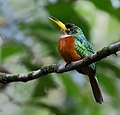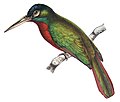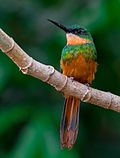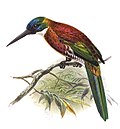| Image | Scientific name | Common name | Distribution |
|---|
 | Galbula albirostris | Yellow-billed jacamar | Brazil, Colombia, French Guiana, Guyana, Suriname, and Venezuela |
 | Galbula cyanicollis | Blue-necked jacamar | Amazon rainforest of Brazil, far northern Bolivia and eastern Peru |
 | Galbula ruficauda | Rufous-tailed jacamar | southern Mexico, Central America and South America as far south as southern Brazil and Ecuador |
 | Galbula galbula | Green-tailed jacamar | Brazil, Colombia, French Guiana, Guyana, Suriname, and Venezuela |
 | Galbula pastazae | Coppery-chested jacamar | southern Colombia, Ecuador and far northern Peru |
 | Galbula cyanescens | Bluish-fronted jacamar | western Amazon Basin of Brazil, Peru and far northwestern Bolivia. |
 | Galbula tombacea | White-chinned jacamar | Amazon Basin of Colombia, Amazonas and northern parts of Ecuador and Peru |
 | Galbula chalcothorax | Purplish jacamar | western Amazon Basin of Ecuador, Peru, southern Colombia and western parts of Acre and Amazonas |
 | Galbula leucogastra | Bronzy jacamar | Bolivia, Brazil, Colombia, French Guiana, Guyana, Suriname, and Venezuela |
 | Galbula dea | Paradise jacamar | Bolivia, Brazil, Colombia, Ecuador, Peru and the Guyanas |
|


















